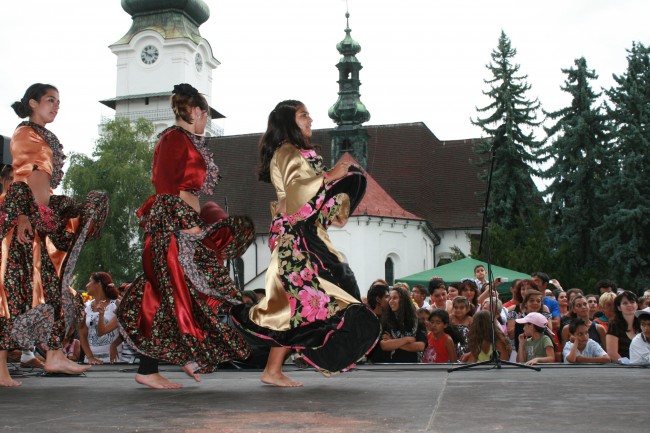Description of the situation
In general it can be said that the Roma family still today represents a traditional type of a multigenerational family (Radičová,2001). The Roma villages represented local communities with a natural leader at the top. In the environment of Vlach Roma, a strictly closed patriarchal family with the elements of lineage relations is maintained up to this day. Mujalo is at the top, this function is inherited. Up to this day they have their own bodies of power (Arne Mann, 2011). The head and the holder of prestige is the father of the family. The woman is always responsible for the household as well as providing enough food for the family and especially the mother decides on the education of her children. In a Roma family the woman as the mother plays an important role. However, if she is barren and cannot have children, she is at the very bottom of the social structure of this society (Vaňová,2014). The Roma are often accused of too numerous offspring. The reason for this is not the ignorance of birth control, as it is usually stated, but the fact that the children are viewed as happiness, just like in India. In the Roma language there is a saying: “but čhave, but bacht (many children, much happiness) (Hancock, 2005).
In the spiritual culture of the Roma there are a number of archaic displays. The most archaic customs are tied to death and burial. There is a complex of strictly upheld magic practices, which stem from a widespread belief in the return of the dead. The majority of the Roma in Slovakia are of Roman Catholic religion. ThefFamilies of the developed Roma frequently display an active relation towards religion (Arne Mann, 2011). The native Roma applied themselves to traditional crafts (blacksmiths, kettle-makers, bell-makers, coalmen, basket-makers, brick-makers, washing cradle-makers) and music. After some time, jobs like horse traders, smithery, prophecy, bear taming, music and dance, healing and others became family professions (Cangár, 2003). The spread of industrial manufacturing led to the fall of Roma smithery. The Valach Roma applied themselves mostly as horse traders, door-to-door sale and collecting materials. From the end of the 19th century, the majority of the Roma worked as workers. Part made their livelihood through journeywork or service. Begging was also a frequent livelihood. After World War II, the Roma worked as construction, railway or forest workers; in the country in agricultural cooperatives. Many Roma got higher than basic education; some even university education and they applied themselves in various fields of agricultural and social life (Arne Mann, 2011). A significant, although frequently only a supplemental way of livelihood of Slovak and Hungarian Roma was music. At the turn of the 19th and 20th century, the best musicians comprised a separate social class of city professional coffee shop musicians, so called gipsy aristocracy. These musicians almost assimilated themselves and place great emphasis on the musical education of their children to this date (Vaňová,2014). The Roma have a rich folklore. During the 18th century, the Roma adopted an individual musical style, which they interpreted mostly in city coffee shops. A significant part of the folklore is comprised of riddles and proverbs, which displays their life wisdom, ethical norms and philosophy (Arne Mann, 2011).
The Roma symbols contain the Roma flag and Roma anthem. The Roma flag is comprised of two stripes – bottom green symbolizing nature and top blue representing sky. In the middle there is a red carriage wheel with sixteen spikes. Since the same wheel is used also on the state flag of India, the Roma have acknowledged in this way the country their ancestors had left a thousand years ago. The Roma song "Gejľem, gejľem" also known as "Geľem, Geľem", "Djelem, Djelem", "Opre Roma", "Romale, čhavale", etc. is considered as the Roma anthem. The Roma anthem is frequently played at the meetings of the Roma activists or celebrations of the International Roma day. (http://www.romovia.vlada.gov.sk/3549/romske-symboly.php).

Source: http://www.mecem.sk/933/romska-kultura-pohlad-zvnutra
References
- Cangár, J. 2003. Ľudia z rodiny Rómov, Vydavateľstvo CROCUS. Nové Zámky 2002
- Radičová, I. 2001. Hic Sunt Romales. Bratislava: Nadácia S:P:A:C:E:, 2001, 318 s. ISBN 80-88991-13-7
- Hancock, I. 2005. My rómsky národ. Ame sam e Romane džene. Bratislava: Petrus Publisher, 2005. ISBN 80-88939-97-6.
- Vaňová, J. 2014. Rómska kultúra – pohľad zvnútra. In Rómske mediálne centrum (MECEM). Available at: http://www.mecem.sk/933/romska-kultura-pohlad-zvnutra
- Úrad Splnomocnenca Vlády pre Rómske komunity. Rómske symboly. Available at: http://www.romovia.vlada.gov.sk/3549/romske-symboly.php
- Mann, A. 2011. Rómovia na Slovensku. Available at:: http://www.ludovakultura.sk/index.php?id=3865ormal'>
